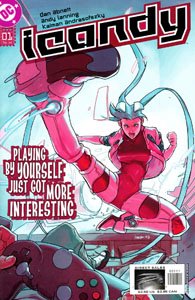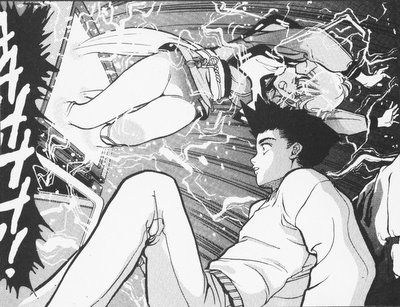 When a remarkably inept marketing venture between Apple Mackintosh and Mattel goes horribly wrong, the prototype "Cyborg Fun Barbie" is disowned by both companies and is left to fend for herself; with a truly random access memory and an obsession with the colour pink, she is the living doll known as iCandy.
When a remarkably inept marketing venture between Apple Mackintosh and Mattel goes horribly wrong, the prototype "Cyborg Fun Barbie" is disowned by both companies and is left to fend for herself; with a truly random access memory and an obsession with the colour pink, she is the living doll known as iCandy.When I first started playing the online superhero game City of Heroes, I decided it would be fun to create a female robot character. I thought I was very clever to call this character iCandy, and it was only several months later that I discovered that there had been a comic that used the same name. Luckily it wasn't very successful and nobody seems to have heard of it. But it piqued my interest and when I found copies of the series in the bargain bin of a comic shop I bought them. Something like a year later I've finally got around to reading beyond the first issue.
 icandy is a comic that wants to be an anime when it grows up. Or possibly a video game. At the very least, a manga. In Japan the lines blur rather more than they do in the west. A story might start out as a manga, anime, or video game and then get adapted into one or more of the others so faithfully that you forget which came first. And they often integrate to the point where you can't get the full story unless you have experienced different media versions. Many anime assume a familiarity with the manga they are based on, and don't even bother introducing characters and situations, assuming that the viewer will already be familiar with them, or like the Sakura Wars OAV series which is in many ways the backstory to the video game, and there are gaps in the anime where the action of the game takes place.
icandy is a comic that wants to be an anime when it grows up. Or possibly a video game. At the very least, a manga. In Japan the lines blur rather more than they do in the west. A story might start out as a manga, anime, or video game and then get adapted into one or more of the others so faithfully that you forget which came first. And they often integrate to the point where you can't get the full story unless you have experienced different media versions. Many anime assume a familiarity with the manga they are based on, and don't even bother introducing characters and situations, assuming that the viewer will already be familiar with them, or like the Sakura Wars OAV series which is in many ways the backstory to the video game, and there are gaps in the anime where the action of the game takes place.The comic takes the visual style from japanese video games for the design of its heroine, Candy, and the storyline steals liberally from manga/anime from the moment where Candy first makes her dramatic entrance in a way that magical schoolgirls have been doing ever since Video Girl Ai first fell out of a TV set in 1989. You can liven up your reading experience by making a game of playing Spot The Cliche as you go.


Above: Video Girl Ai
Right: The icandy variation
Right: The icandy variation
The story, such as it is: sullen adolescent Matt Delaney (he's such a teenager that he doesn't even speak until page 17, ignoring direct requests from teachers, other students, and even his mother. You begin to wonder if he's deaf and nobody has noticed) receives an experimental prototype games console from his father (parents are divorced and he lives with his mother) who does something unspecific in the whole console design field (so unspecific that he has no clue what he's really working on) and doesn't appear to be aware of the extreme level of security that surrounds the industry he works in. Matt plugs the console in, which seems to have a pre-loaded game, and selects a character who just happens to resemble his missing sister.
I assumed when I read this that Dad did this on purpose, creating the character as some kind of homage to his lost daughter, but it turns out later that he knows nothing about it. Apparently he hasn't actually played the only game on the console he's designing. So of course Matt selects this character and wouldn't you know it? At the exact moment he hits the Play button, the system is struck by lightning and Candy rises from the shattered remains of the TV (the console itself is completely undamaged, which is a bit odd considering that surely it's the power surge to the console that causes her to materialise). Then she jumps through the window (which is closed at the time) and runs away. Matt chases her and she jumps about a lot and acts like a video game character, even to the extent of being able to pull up menu windows out of thin air.
 The next 3 issues involve Matt and Candy traveling across country and getting in fights along the way. Matt is going to find his dad, and Candy is under the impression that dad's boss = level boss and she must defeat him to reach the next level. They are being chased by generic evil blobby things, generic corporate thugs, and a generic bounty hunter type. Meanwhile Dad receives a note from "a friend" (who is never identified) that tips him off to the blindingly obvious situation that the skyscraper he works in is virtually deserted. He's such a geek. Matt and Candy finally arrive and we get this big infodump explaining the plot, which involves aliens from another dimension accessing our world through video games so the company has been building a game in which they can fight back. The real Candy disappeared while playtesting this game and game warrior Candy is of course specially important because she is the only game character that's been able to survive in the real world for more than a few minutes so they want to find out how she does it.
The next 3 issues involve Matt and Candy traveling across country and getting in fights along the way. Matt is going to find his dad, and Candy is under the impression that dad's boss = level boss and she must defeat him to reach the next level. They are being chased by generic evil blobby things, generic corporate thugs, and a generic bounty hunter type. Meanwhile Dad receives a note from "a friend" (who is never identified) that tips him off to the blindingly obvious situation that the skyscraper he works in is virtually deserted. He's such a geek. Matt and Candy finally arrive and we get this big infodump explaining the plot, which involves aliens from another dimension accessing our world through video games so the company has been building a game in which they can fight back. The real Candy disappeared while playtesting this game and game warrior Candy is of course specially important because she is the only game character that's been able to survive in the real world for more than a few minutes so they want to find out how she does it.Then the backup "hardlight" characters (who haven't even been programmed yet) get possessed by the aliens for no reason that makes any sense and Candy has to fight them.
One thing that surprised me was that icandy was not, as I had assumed, a mini-series. According to this interview, artist Kalman Andraofszky was contracted to 12 issues. How much warning the creators got of the comic's demise is debatable. Issue #6 does complete a story arc, but with the cliffhanger of Candy apparently killed when she self-destructs the battle armour she is wearing to defeat the other game characters. The epilogue sequence where she pops up again to let us know she survived seems rushed and pointless and doesn't explain anything. It just seems to be tacked on to give it an upeat ending, where leaving her fate uncertain would have been far more effective.
The other thing that surprised me is that icandy is only the name of the comic. The character is only ever referred to as Candy. Which means I wasn't unintentionally copying a character name already in use.
Cool.
1 comment:
Your origin story is much cooler.
Bill Burns
Post a Comment